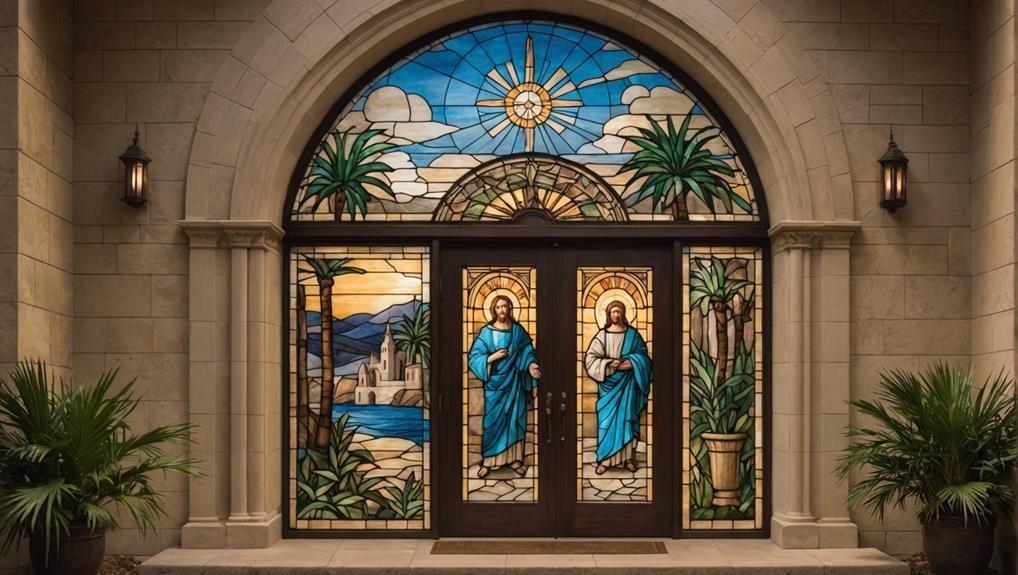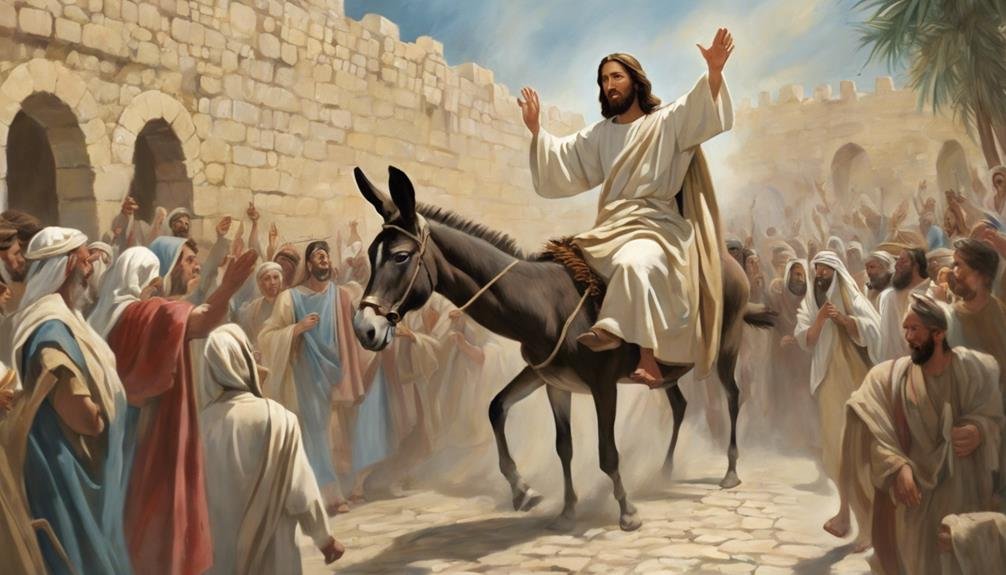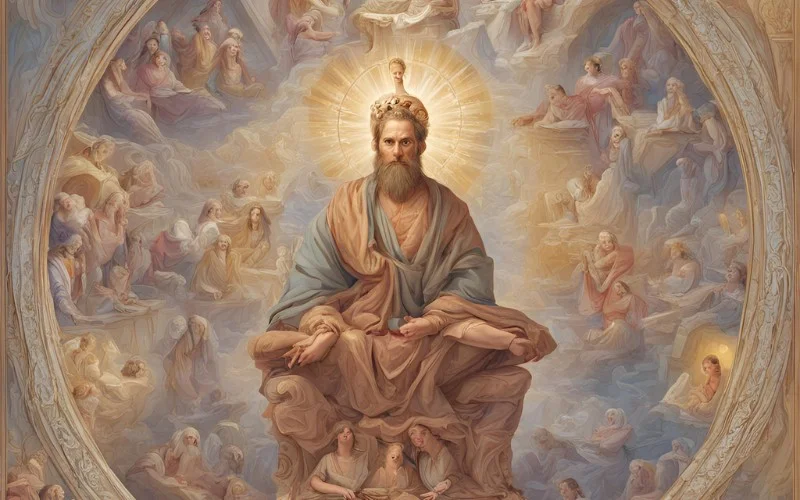You might wonder why Palm Sunday is celebrated so significantly in Christianity. It marks the start of Holy Week and commemorates Jesus Christ‘s entry into Jerusalem, an event steeped in prophetic fulfillment and symbolic gestures, like the spreading of palm branches, which were signs of victory and kingship.
This day celebrates Jesus as the Messiah and sets the stage for unfolding critical events that define the Christian faith. As you explore the layers of this celebration, you’ll discover how deeply its rituals and symbols are woven into the fabric of Christian theology and how they echo a message that resonates across centuries.
Key Takeaways
- Palm Sunday commemorates Jesus’ triumphant entry into Jerusalem, fulfilling biblical prophecies.
- It marks the beginning of Holy Week, leading to Jesus’ crucifixion and resurrection.
- Believers use palm branches to symbolize victory and peace, echoing Jesus’ welcome by the crowds.
- The celebration emphasizes Jesus’ agenda of sacrificial love and salvation.
- Palm Sunday rituals globally unite Christians in reflection and devotion to Jesus as Savior.
Historical Background of Palm Sunday
Palm Sunday, originating in the 3rd century at the Jerusalem Church, marks a pivotal moment in Christian tradition.
As you explore its roots, you’ll discover that this day isn’t just another Sunday in the Christian calendar but a profound commemoration of Jesus’ triumphant entry into Jerusalem.
The early Christians in Jerusalem set the stage for a lasting tradition across centuries. Imagine being part of those early ceremonies, where hymns and prayers filled the air, each resonating with deep devotion and reverence for Christ.
You’d witness the blessing of hands, a sacred ritual symbolizing the sanctification and readiness to serve God. Biblical passages were recited, echoing through the congregation and reinforcing the messages of faith and triumph central to the occasion.
These traditions, established in the third century, persisted and evolved, deeply ingraining Palm Sunday in the fabric of Christian worship.
Palm branches, significant for their symbolism of honor and triumph, played an important role in the ceremonies, though their specific significance unfolds further in the tradition’s development. You’re seeing a ceremony steeped in history, meant to honor the beginning of Holy Week with deep spiritual resonance.
Significance of Palm Branches
Reflecting on the historical context, you’ll find that the use of palm branches during Palm Sunday has deep symbolic significance. In Christian tradition, these branches aren’t just foliage but symbols of victory and peace.
When you celebrate Palm Sunday, you’re echoing the sentiments of ancient believers who marked Jesus’ entry into Jerusalem as a momentous occasion. This symbolism is woven deeply into the fabric of Holy Week, embodying the triumph of spiritual over worldly power.
Waving palm branches as you commemorate this day isn’t merely a ritual. It’s a profound welcome gesture, signifying Jesus’ entry into Jerusalem and the hearts of believers.
This act is charged with meaning, reminding you that Palm Sunday isn’t just a historical reenactment; it’s a lively, ongoing invitation to reflect on your faith and the peace that Jesus brings.
Moreover, when these branches are blessed by clergy in Catholic and other Christian churches, they transform from simple natural objects to sacred items.
This blessing, a cornerstone of the Palm Sunday service, highlights the branches’ importance in connecting the congregation with the divine. Therefore, each Palm you hold connects you to a centuries-old tradition, celebrating Jesus’ enduring influence and the eternal hope He offers.
Biblical Narratives of The Entry
The biblical narratives of Palm Sunday, detailed in Matthew, Mark, Luke, and John, vividly recount Jesus’ humble yet triumphant entry into Jerusalem on a donkey.
As you explore these accounts, you’ll see each Gospel painting a slightly different picture of the same event, emphasizing the fulfillment of the prophecy in Zechariah 9:9.
This prophecy highlights a king who comes in peace, riding on a donkey, not a warhorse, setting Jesus apart from earthly kings.
As Jesus entered Jerusalem, the crowd’s actions spoke volumes. They laid palm branches on the road, signaling honor and royal treatment, while their shouts of ‘Hosanna’ echoed the streets, proclaiming him as the anticipated savior.
This scene isn’t a simple entry, a profound declaration of Jesus’ identity and mission. Palm Sunday isn’t only about remembering this entry; it marks the commencement of Holy Week, a sacred time leading to Easter, focusing on Jesus’ passion, death, and resurrection.
Understanding this context, you begin to appreciate the depth of what seemed like a simple moment. Jesus’ choice of a donkey as his steed and the public’s response with palm branches intertwine to kickstart a week of profound spiritual significance in Christianity.
Jesus’ Agenda in Jerusalem
Having explored the events of Palm Sunday, let’s examine why Jesus came to Jerusalem. He aimed to fulfill a divine mission centered on salvation through his upcoming sacrifice. Jesus wasn’t just making a grand entrance with his arrival in Jerusalem but fulfilling a prophecy.
As foretold in Zechariah 9:9, his choice to ride a donkey was laden with meaning, signaling his role as the King of Peace. This decision wasn’t random; it was chosen intentionally to represent humility and peace. Contrasting sharply with the typical war-conquering kings who rode horses.
This humble entrance on a donkey resonated deeply with the crowds. Who greeted him with palm branches, symbols of victory and honor, recognizing him as their anticipated savior. Yet, Jesus’ agenSaviort far beyond these immediate accolades.
He was in Jerusalem with a profound and paradoxical purpose: to bring salvation through his sacrificial death. This act was to be the ultimate demonstration of his kingship, not marked by earthly power but by a sacrificial love that would forever redefine the notion of victory and honor in the hearts of his followers.
Reactions to Jesus’ Arrival
As Jesus entered Jerusalem, the crowd’s enthusiastic welcome, including palm branches and shouts of ‘Hosanna,’ highlighted their recognition of him as the prophesied Messiah and King.
You can almost picture the scene: the dusty roads of Jerusalem bustling with excitement, each person vying for a glimpse of the man who’d stirred so much hope and controversy.
This vibrant celebration, Palm Sunday, marked a high point in Jesus’ ministry and a pivotal moment in Christian history. The very streets of Jerusalem, filled with joyous shouts and strewn with palm branches, bore witness to the fulfillment of ancient prophecies.
But this celebration was tinged with irony. The same voices that cried ‘Hosanna’—a plea for salvation—would, in just a few days, shift in a dramatic and dark turn leading to Jesus’ crucifixion.
You’re witnessing a profound juxtaposition: a festive entry that ushers in a week of profound sorrow and transformation. This duality encapsulates the complex human responses to Jesus’ arrival—reverence mixed with misunderstanding, celebration poised on the cusp of tragedy.
It’s a pivotal reminder of how quickly tides can turn, setting the stage for Holy Week’s events culminating in resurrection and redemption.
Prophecies Fulfilled on Palm Sunday
Reflecting on this jubilant arrival. Palm Sunday wasn’t just a pivotal event and a profound fulfillment of biblical prophecies. When you consider Jesus’ entry into Jerusalem, you’re witnessing a scene that resonated deeply with scriptural predictions.
Riding on a donkey, Jesus not only chose a symbol of humility and peace but also directly fulfilled the prophecy from Zechariah 9:9. This moment underscored his role as a peaceful Messiah, contrasting sharply with the expectations of a militant savior.
Palm Sunday marked the beginning of Jesus’ final journey, which would lead him through crucifixion towards resurrection. This wasn’t just a somber march towards the end but a fulfillment of the destiny in the Old Scriptures.
The crowds, waving palm branches and chanting ‘Hosanna,’ weren’t just celebrating his arrival; they were unwittingly confirming ancient prophecies that heralded the coming of the Savior.
This day, Savior, is merely a remembrance of a historical event but a celebration of the fulfilled prophecies. That tie together significant aspects of the Christian faith—the humility, peace, and ultimate sacrifice of Jesus as foretold by the prophets.
Modern Celebrations Worldwide

Today, Christians around the globe observe Palm Sunday with varied traditions that highlight its universal significance. The day is marked with solemnity and joy in every corner of the world, from the bustling cities of America to the serene towns of Africa.
It’s the beginning of Holy Week, a time to reflect on the Passion of Christ and prepare for Easter. As you step into churches worldwide, you’ll notice the common elements that define Palm Sunday celebrations.
There’s usually a procession, often beginning outside the church grounds. Participants carry palm branches, symbolizing the palms strewn before Jesus as he entered Jerusalem. These palms are later blessed, turning ordinary leaves into symbols of faith and devotion.
During the service, you’ll hear readings from the Bible, recounting Jesus’ triumphant entry and the events leading to his crucifixion. These stories are shared in various languages and styles, adapted to local cultures yet maintaining the core message.
Across the globe, Christians unite in these acts of remembrance and devotion, demonstrating Palm Sunday’s widespread impact and enduring relevance in the Christian faith. Through these observances, the spiritual journey of Holy Week begins, connecting believers in a shared experience of reverence and renewal.
Rituals and Customs Explained
Let’s explore the specific rituals and customs that define Palm Sunday in various Christian traditions. This day marks the triumphal entry of Jesus into Jerusalem, an event loaded with deep symbolism and solemnity.
In many churches, the liturgy begins with a procession reminiscent of the jubilant crowd that once welcomed Jesus. You might see palms being waved, a vivid symbol of victory and peace.
This narrative isn’t just a story; it’s a call to explore the depths of Jesus’ sacrifice, symbolized by the red robes worn today. In this moment, you’re not just a spectator; you’re participating in a profound act of remembrance and dedication.
Impact on Christian Theology
Palm Sunday profoundly influences Christian theology, highlighting Jesus’ sacrificial journey and its essential role in redemption and salvation.
As you explore the significance of this day, you’ll see how it not only commemorates Jesus’ triumphant entry into Jerusalem but also sets the stage for the profound events of Holy Week. This period reflects the core Christian belief that humanity finds redemption through Jesus’ suffering and death.
The celebration of Palm Sunday establishes a fundamental tone that permeates the entire Holy Week, encouraging you to reflect on Jesus’ selfless love and ultimate sacrifice.
This focus is vital as it embodies the heart of Christian theology, emphasizing Jesus’ mission to offer salvation through his own life. It’s a powerful reminder of his profound sacrifice, willingly facing crucifixion for the salvation of all.
This observance also reinforces your understanding of Jesus as the Messiah, a pivotal figure prophesied to bring salvation to humanity.
Reflections and Spiritual Insights
Considering Palm Sunday’s theological impact, consider how this observance inspires deep spiritual insights into your faith journey.
As you recall, Jesus’ triumphal entry into Jerusalem was marked by the scattering of palm leaves. It’s a moment that celebrates Jesus’ kingship and the beginning of Holy Week.
This pivotal event isn’t just a historical recount; it’s a personal invitation to reflect on Jesus and embrace the humility and servanthood He modeled. Palm Sunday is rich with symbolism. The significance of Palm represents peace and mercy, reminding us of Jesus’ victory over sin.
As you hold those palm leaves, remember they’re botanical artifacts and symbols of your call to victory in Christ.
This day profoundly reminds you of your role in a larger spiritual saga. Let it renew your heart and guide your steps as you continue your journey in faith, welcoming Jesus anew into your life.
Conclusion
As you reflect on Palm Sunday, remember that it’s not just about historical events but also about a personal call to recognize Jesus’ sacrificial journey. Embrace the symbolism of palm branches, representing victory and triumph, and let them inspire you in your spiritual battles.
This day marks a pivotal moment in Christianity. It urges you to contemplate Jesus’ teachings and their transformative power. Celebrate, reflect, and prepare for the profound journey of Holy Week.
Learn More Articles:
10 Top Palm Sunday Recipes to Celebrate Joyfully
10 Best Symbols of Palms in Christian Worship
Pentecost: Celebrating the Holy Spirit’s Descent




